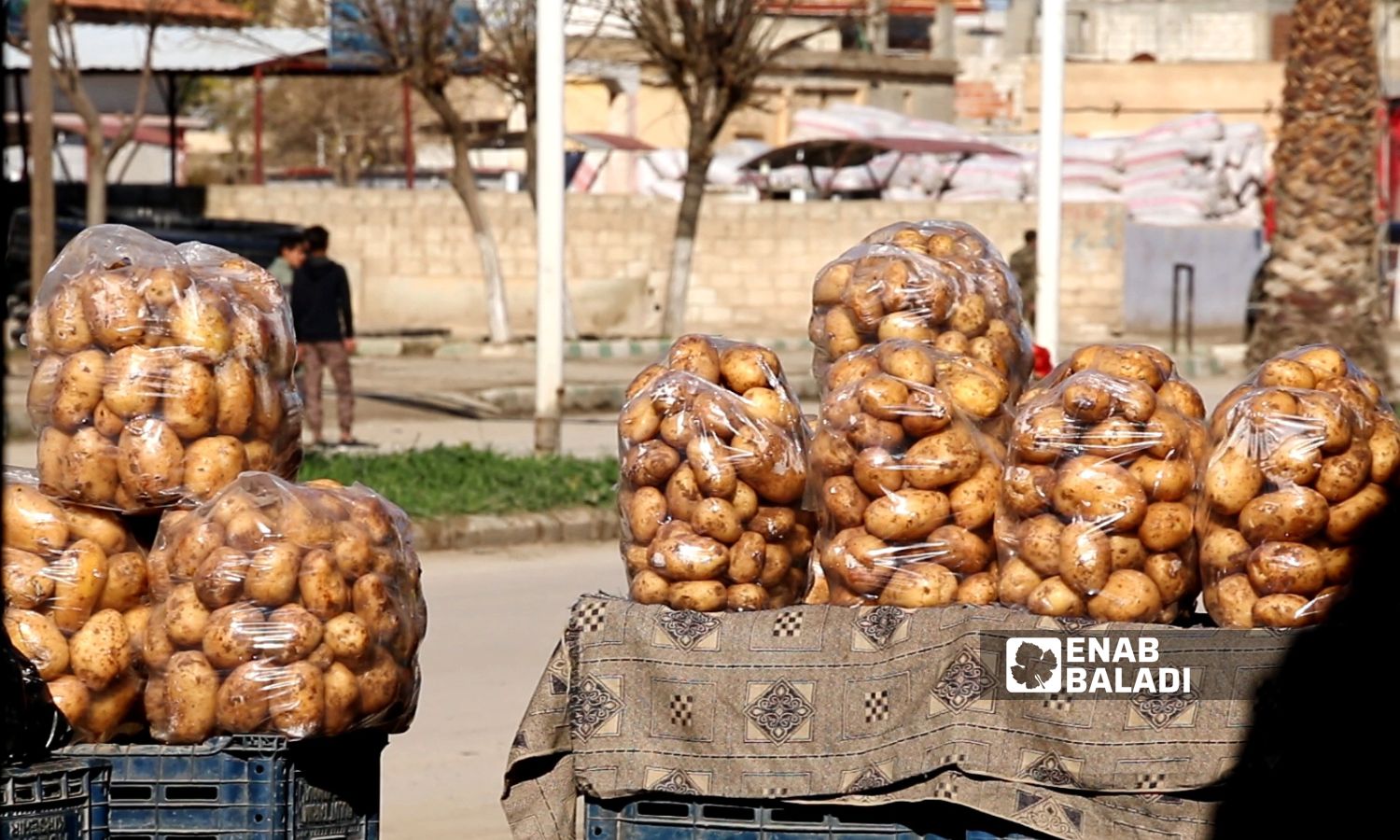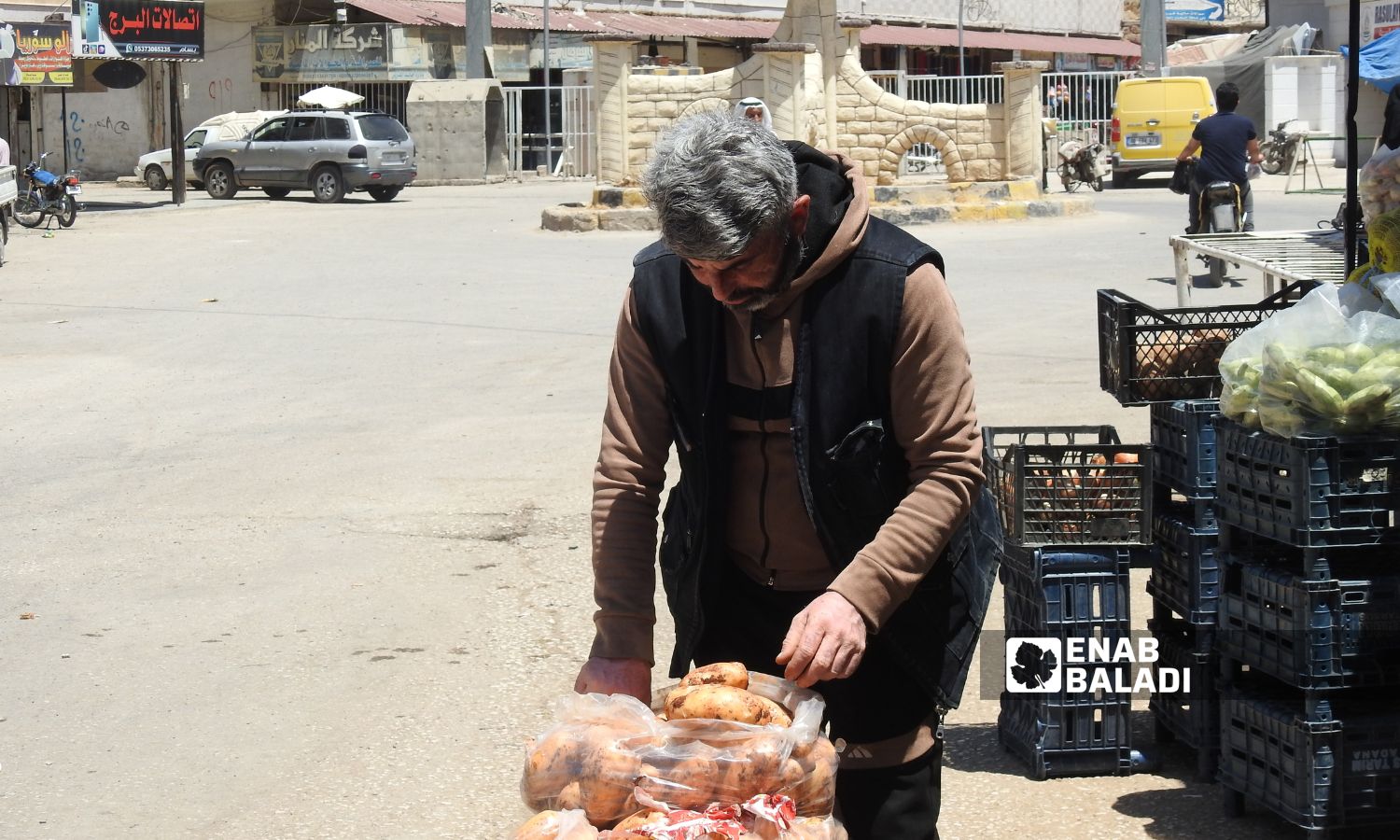



Enab Baladi – Ras al-Ain
Potato prices continue to rise in Ras al-Ain, northwestern al-Hasakah, with the price reaching 7000 Syrian pounds per kilogram. This is due to reliance on imported potatoes in the absence of local production that meets market demand.
Potatoes arrive in Ras al-Ain mainly through Turkey, which is the primary supplier. Additionally, quantities come from the northern and eastern countryside of Aleppo via transit routes (from Aleppo countryside to Turkey and then to Ras al-Ain).
The price increases due to import costs, transportation expenses, customs duties, and commissions imposed by traders, which directly impacts the final consumer price.
The presence of potatoes on the dining table has declined compared to other vegetables. Residents interviewed by Enab Baladi stated that potatoes are no longer “the poor’s meat” as they used to be.
Malaak al-Mohammad, a resident of Ras al-Ain, no longer buys potatoes regularly as she did in previous years. She mentioned that she has stopped including them in dishes that were made every two or three days.
Hassan al-Fahd, another resident of Ras al-Ain, said that potatoes were a real blessing for him and his family, forming a large part of their daily meals due to their previously affordable price, making it easy for him to provide them consistently.
He added to Enab Baladi that now he can barely buy more than one kilogram of potatoes at a time, which forces him to reduce their consumption.
Potato prices remain high while the prices of all summer vegetables have nearly halved, with one kilogram of tomatoes costing 3000 pounds, eggplants 2000 pounds, cucumbers 3000 pounds, and zucchini 1000 pounds.
Daily wage laborers in Ras al-Ain earn between 80,000 and 100,000 Syrian pounds (with 1 USD equivalent to 15,200 Syrian pounds).

Potato prices are witnessing a rise compared to all other vegetables in Ras al-Ain – August 28, 2024 (Enab Baladi)
The low demand for potatoes has resulted in financial losses for vendors as they remain unsold for long periods, eventually spoiling.
Ismail al-Rumayd, a vegetable stall owner in Ras al-Ain, told Enab Baladi that the high potato prices are causing him financial losses. He finds it difficult to sell to consumers who can no longer afford the high prices.
He explained that potatoes used to be one of the most demanded items but now struggle to sell, often remaining on the stall for extended periods, leading to spoilage before they can be sold.
Al-Rumayd added that he previously sold around 60 kilograms of potatoes daily, but now he cannot sell more than 15 kilograms.
He indicated that if this situation continues, his losses will increase, and he might have to stop selling potatoes entirely if conditions do not improve soon.
Potatoes are not a primary crop in Ras al-Ain compared to wheat, cotton, and barley.
Agricultural engineer Fouad Kamali from Ras al-Ain told Enab Baladi that the high cost of growing potatoes and lack of sufficient expertise have led residents to rely on imported potatoes.
He explained that one dunam (1,000 square meters) requires about 250 kilograms of potato seeds. Hence, the cost for planting one dunam is around $600, with the price of ordinary seed potatoes at $2,500 per ton, and high-quality seeds at $4,000 per ton.
Kamali added that the agricultural lands in Ras al-Ain are suitable for cultivating potatoes, but it requires significant care and expertise, which most farmers lack.
He noted that some farmers who have tried growing potatoes faced substantial losses due to various diseases such as bacterial wilt, whiteflies, and early and late blight, leading to root spoilage and difficulties in harvesting.
Kamali stated that if potatoes are cultivated carefully using disease-free seeds and fertilizers, yields could range between 4 to 6 tons per dunam, yielding significant profits. However, cultivating them without the necessary expertise can lead to major financial losses.
Ziad Malaki, the spokesperson for the local council, said the council encourages all kinds of agriculture, including potato cultivation in the region, and provides consultations to farmers.
He told Enab Baladi that most farmers opt for seasonal crops like wheat, cotton, cumin, and beans, which are less costly compared to potatoes that also require special care.
Malaki added that the high potato prices are due to transportation and loading costs from northern Syria and Turkey, which keeps their prices high and stable without any decrease.
He mentioned that the local council plans to cultivate potatoes under the supervision of agricultural engineers and supervisors to reduce prices in the region.
He urged residents to seek advice from the Agricultural Directorate in Ras al-Ain for potato cultivation and to utilize plowing services provided by the local council to develop this agriculture and prevent the monopolization of this product.
Agriculture and livestock farming are among the primary occupations for most residents of Ras al-Ain and northeastern Syria, serving as a major source of income in these areas.
Agricultural crops in Ras al-Ain face marketing difficulties, trader monopolies, and the absence of government bodies purchasing strategic crops in the region.
if you think the article contain wrong information or you have additional details Send Correction